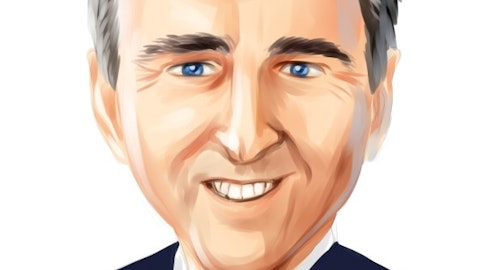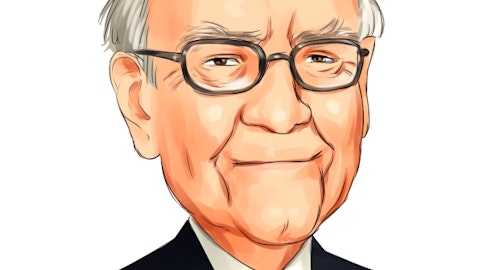U.S. Bancorp (NYSE:USB) Q4 2022 Earnings Call Transcript January 25, 2023
Operator: Welcome to the U.S. Bancorp Fourth Quarter 2022 Earnings Conference Call. Following a review of the results, there will be a formal question-and-answer session. This call will be recorded and available for replay beginning today at approximately 11:00 A.M. Central Time. I will now turn the conference call over to George Andersen, Senior Vice President and Director of Investor Relations for U.S. Bancorp.
George Andersen: Thank you, Brad and good morning everyone. With me today are Andy Cecere, our Chairman, President and Chief Executive Officer; and Terry Dolan, our Vice Chair and Chief Financial Officer. During their prepared remarks, Andy and Terry will be referencing a slide presentation. A copy of the presentation as well as our earnings release and supplemental analyst schedules are available on our website at usbank.com. I would like to remind you that any forward-looking statements made during today’s call are subject to risk and uncertainty. Factors that could materially change our current forward-looking assumptions are described on page two of today’s presentation, in our press release, our Form 10-K, and in subsequent reports on file with the SEC. Following their prepared remarks, Andy and Terry will take any questions that you have. I will now turn the call over to Andy.
Andy Cecere: Thanks George. Good morning everyone and thank you for joining our call. I’ll begin on slide three. This quarter, we completed the acquisition of MUFG Union Bank on December 1st. In the fourth quarter, we reported $0.57 per diluted share or $1.20 after adjusting for notable items related to the acquisition. This was a complex quarter that included one month of Union Bank results, merger integration charges, and balance sheet optimization activity. Terry will provide more details on these notable items. Importantly, we ended the year with a common equity Tier 1 ratio of 8.4%, which was just above our expected level at deal close and we delivered positive operating leverage for U.S. Bancorp legacy operations of 230 basis points for the full year.
Strong year-over-year pre-tax provision income growth as adjusted for notable items was driven by net interest income growth and positive operating leverage. Credit quality remains strong, although credit metrics are starting to normalize as expected. Slide four details are reported and adjusted income statement results as well as end-of-period balances and other performance metrics. End-of-period assets for the company totaled $675 billion, reflecting the acquisition of Union Bank and certain balance sheet optimization actions. Slide five highlights key performance ratios. This quarter, we delivered a return on average assets of 1.2%, a return of average common equity of 16.8%, and a return on tangible common equity of 23.4%, each as adjusted for notable items.
Turning to slide six. The completion of the Union Bank acquisition marked a significant milestone for our company. With double-digit percent increases in loan and deposit balances, Union Bank adds meaningful scale to our business that enables us to better serve our customers and communities. Union contributes considerable small business and consumer market share in a demographically attractive California market, and we’re excited about the potential to deepen existing Union Bank relationships by overlaying our leading digital capabilities and robust product set, including wealth management, consumer and business banking and payments offerings across a loyal but under-penetrated consumer base. In many ways, this deal underscores our commitment to creating a stronger, more competitive regional banking organization in a rapidly evolving environment.
One of the more attractive aspects of this transaction is Union Bank’s high quality, low cost consumer deposit franchise, which will support continued loan growth and margins. Let me turn the call over now to Terry, who will provide more detail on the quarter.
Terry Dolan: Thanks, Andy. If you turn to slide 7, as Andy mentioned, we reported diluted earnings per share of $0.57 for the quarter or $1.20 per share after adjusting for notable items related to the acquisition. Notable items related to Union Bank acquisition are comprised of three primary elements that reduced earnings per share by $0.63 related to balance sheet optimization, merger and integration costs, and the impacts of — on provision expense related to acquired loans and actions taken to optimize the balance sheet. During the fourth quarter, the company recognized a one-time $399 million pre-tax loss on a net basis related to several actions taken to optimize the balance sheet, manage the interest rate volatility impact on capital levels and position the company for future growth.
Subsequent to obtaining regulatory approval for the transaction, we entered into interest rate hedges to manage rate volatility and its related impact on regulatory capital from the date of approval through the closing of the transaction in December. During that time frame, long-term interest rates increased nearly 50 basis points before declining approximately 65 basis points. The interest rate swaps were terminated at the time of closing, and the losses recognized through earnings largely offset the interest rate marks recorded into the balance sheet through purchase accounting. In addition, the company optimized its balance sheet by selling certain loans and repositioning its investment portfolio on certain equity investments. Within non-interest expenses, we incurred merger and integration related charges of $90 million that primarily included the impact of specific deal closing costs, professional services and employee related expenses.
We also incurred a $791 million charge to the provision for credit losses, which reflects an initial provision impacted by the acquisition of $662 million and a net loss of $129 million related to the securitization of approximately $4 billion of legacy indirect auto loans. Again, these moves enabled us to more effectively position the balance sheet for profitable growth and optimize returns. Slide 8 provides a more detailed earnings summary. Union Bank, which was included in our consolidated results for one month, contributed $302 million of revenue, $221 million of non-interest expenses, $81 million of operating income and $44 million of net income to the company, representing $0.03 per diluted share. On slide 9, end of period loans increased 13.3% on a linked-quarter basis to $388 billion, which included core loan growth and acquired loans from Union Bank.
Union Bank contributed ending loan balances of $54 billion net of purchase accounting adjustments, partly offset by a reduction in balances of $15 billion related to balance sheet optimization actions, including loan sales and securitizations. Slide 10 provides end-of-period deposit balance composition. End-of-period deposits increased 11.4% on a linked-quarter basis to $525 billion driven by the acquisition, which contributed $86 billion of lower-cost deposits, and actions taken as a result of the deal to optimize our funding sources. On a core basis, we saw deposit balances decline slightly this quarter. Turning to slide 11. The investment securities portfolio grew 4.2% linked quarter to $170 billion. The addition of securities from Union Bank were offset by balance sheet optimization actions.
Slide 12 highlights revenue trends. Adjusted net revenue totaled $6.8 billion in the fourth quarter, which included revenue contribution of $302 million from Union Bank, primarily representing net interest income. For legacy US Bancorp, net interest income grew 5.5% on a linked-quarter basis and 29.2% year-over-year driven by strong earning asset growth and net interest margin expansion, which benefited from rising interest rates. Results were partially offset by higher deposit pricing and short-term borrowing costs. Non-interest income, as adjusted for the legacy company, declined 3.0% compared to the third quarter driven by seasonally lower payment service revenue and lower commercial product revenue, offset by stronger mortgage banking revenue.
Year-over-year, legacy adjusted non-interest income declined 5.5% driven by lower mortgage banking revenue from reduced refinancing activity and lower servicing charges, offset by stronger payment services revenue and trust and investment management fees. Turning to slide 13. Adjusted non-interest expense totaled $4.0 billion in the fourth quarter, including $221 million from Union Bank. Included in expenses was approximately $42 million of intangible amortization due to core deposit intangibles established at the time of the acquisition. Legacy non-interest expense, as adjusted, increased 3.8% on a linked-quarter basis largely driven by higher compensation-related expenses as well as higher expenses related to professional services, marketing, technology and tax credit amortization.
Slide 14 shows credit quality trends. We reported total net charge-offs for the quarter of $578 million. After adjusting for acquisition impacts and the balance sheet optimization activities, net charge-offs totaled $210 million or 0.23% of average loans, up from 0.19% in the third quarter, which reflected the continuing normalization of credit losses. Non-performing assets for the legacy bank increased slightly, while Union Bank contributed $329 million to the total. On a combined basis, the reported ratio of non-performing assets to loans and other real estate was 0.26% at December 31, compared with 0.20% at September 30, and 0.28% a year ago, reflecting a continued strong credit quality. The provision for credit losses was $1.19 billion, which included a provision of $791 million related to the acquisition and balance sheet optimization activities.
This provision includes an initial provision impacted by the acquisition of $662 million and $129 million related to our balance sheet optimization activities. The allowance for credit losses as of December 31st totaled $7.4 billion or 1.91% of period-end loans, which reflects increased economic uncertainty and the incorporation of the Union Bank portfolio. Slide 15 highlights the drivers of our linked-quarter common equity Tier 1 capital position. As of December 31st, our CET1 capital ratio was 8.4%. Acquisition impacts of 180 basis points included an increase in goodwill and other intangible assets that reflected the impact of credit and interest rate marks, the initial provision for credit losses, balance sheet optimization actions, as well as the increase in risk-weighted assets with the addition of Union Bank.
These impacts were partially offset by an increase to equity related to shares issued to MUFG as part of the purchase price of Union Bank. Slide 16 provides our current expectations of certain financial metrics related to the transaction. The financial and strategic merits of the deal remain intact and are very attractive. Earnings per share accretion is now expected to be 8% to 9% in 2023, which is higher than originally estimated. While our tangible book value per share dilution is higher than initially estimated due to the significant impact of rising interest rates on the interest rate marks at close, our estimated earn-back period is only slightly longer than our original estimate at two years versus our original estimate of 1.5 years.

Slide 17 provides a comparison of credit and net fair value marks from the time of our announcement to closing. Credit marks are lower due to favorable changes in portfolio composition and credit quality, partially offset by economic deterioration. Interest rate marks, inclusive of loans, securities net of sales, and debt, are higher than anticipated at announcement due to higher interest rates, but we expect that to accrete quickly back through earnings. The core deposit intangible is also higher than originally estimated, reflecting the increased value of lower-cost core deposits in a higher rate environment. I will now provide first quarter and full year 2023 forward-looking guidance, which is provided on slide 18, starting with the first quarter 2023 guidance.
We expect average earning assets of between $605 million and $610 billion in the first quarter and the net interest margin that is five to 10 basis points higher than the fourth quarter level. Total revenue is estimated to be in a range of $7.1 billion to $7.3 billion, including approximately $100 million of purchase accounting accretion during the quarter. Total non-interest expense as adjusted is expected to be in the range of $4.3 billion to $4.4 billion, inclusive of approximately $125 million of core deposit intangible amortization related to Union Bank. Our income tax rate as adjusted is expected to be approximately 22% to 23% on a taxable-equivalent basis. We anticipate merger and integration charges of between $200 million and $250 million for the quarter.
I will now provide guidance for the full year. For 2023, average earning assets are expected to be in the range of $610 billion to $620 billion with net interest margin expansion of between five to 10 basis points compared with the fourth quarter of 2022. Total revenue is expected to be in the range of $29 billion to $31 billion, inclusive of between $350 million to $400 million of full year purchase accounting accretion. Total non-interest expense as adjusted for the year is expected to be in the range of $17 billion to $17.5 billion, inclusive of approximately $500 million of core deposit intangible amortization related to Union Bank. Our estimated full year income tax rate on a taxable equivalent basis as adjusted will be approximately 22% to 23%.
We expect to have $900 million to $1 billion of merger and integration charges in 2023. I will now hand it back to Andy for closing remarks.
Andy Cecere: Thanks, Terry. We accomplished a lot this past year, including the completion of the Union Bank acquisition and a strong legacy PPNR growth supported by positive operating leverage on an adjusted basis. Union Bank adds significant scale to our business and deepens our commitment to serving customers and creating economic opportunities for communities across the West Coast. We continue to target a Memorial Day weekend systems conversion, incorporating a lift-and-shift approach to our applications, which mitigates risk and allows us to more quickly capture meaningful cost synergies. There is still a tremendous amount of economic and geopolitical uncertainty, and we are preparing for any scenario. I believe we will perform well because of the strength of our business, a strong balance sheet and the great team we have.
As we’ve proven during previous economic downturns, our business model is resilient and recession ready in large part due to our disciplined through the cycle credit underwriting standards and robust risk management infrastructure. Our consumer clients are predominantly prime, super prime, and our commercial book is generally investment grade, and we have very little leverage lending commitments. We are focused on prudent balance sheet growth, high return, high margin opportunities and the prudent allocation of capital to lines of business and products best served to deliver on our strategic objectives. Our growth strategy is focused on creating value for our customers, communities and shareholders, which allow us to generate industry leading performance.
Let me close by saying thank you to our 77,000 employees across the company, including our newest colleagues from Union Bank. Your dedication and commitment are what make US Bank special and the destination of choice for all the constituents we serve. We’ll now open up the call for Q&A.
See also 10 Best Healthcare Stocks for Recession and 12 52-week Low Dividend Stocks To Consider.
Q&A Session
Follow Us Bancorp (NYSE:USB)
Follow Us Bancorp (NYSE:USB)
Receive real-time insider trading and news alerts
Operator: We will now begin the question-and-answer session. And we can first go to Scott Siefers with Piper Sandler. Please go ahead.
Andy Cecere: Good morning Scott.
Terry Dolan: Hi, Scott.
Scott Siefers: Maybe a question for you. Just at the top level, was hoping you could speak to what balance sheet and capital management will look like for you. So you’re still under $700 billion in assets. But any thought on limiting growth, or will there be additional sales or securitizations to help keep you under there? And then, I guess, on repurchase, I know we’re on pause until we get back to the common equity Tier 1 target. But with the looming category move up, would there be any thought to hold off longer than that just to sort of see what happens? Just any thoughts on either of those would be great, please.
Andy Cecere: Scott, I’ll start. This is Andy and Terry will add in. So first of all, we’re not limiting growth in the company. We €“ one of the reasons we positioned the balance sheet and took the optimization actions we talked about, Terry went through, was to allow for profitable growth. It also was related to the credit box that we manage within as well as the returns that some of those categories of assets that we securitized were returning. So those are all allowing us to grow in a profitable way in the future. As we talked about before, we not expect to cross the threshold of a Cat II until the earliest at the end of 2024, and that’s into the new category at that time. And if we have any further balance sheet optimization actions in securitizations, they would be very nominal and not material in nature. Terry, what would you add?
Terry Dolan: Yeah. No, I would just again reiterate, we’re ready to be able to adopt Category II by the end of 2024. But there’s no real cap. We wouldn’t expect any real significant balance sheet optimization from here. And we spent a lot of time positioning the balance sheet for growth as we go forward.
Scott Siefers: Wonderful. And then just sort of thoughts on repurchase as well? I know, we’re on pause for now, but it’s still sort of a crush mark, so would be curious to your thoughts?
Terry Dolan: Yeah, Scott. So as we’ve said in that, we continue to expect that. We are starting about a good spot, about 8.4% CET1. We expect that to creep up to at or above 9% by the end of next year, and it continue to accrete 2023 and continue to move up from that particular point. So one of the things, we’ll do is once we get to above 9%, we’ll have to make an assessment as to all the different things that are happening out there from a regulatory perspective. I mean, you have the regulators looking at Basel III and are having to think about Category II and those sorts of things. But I think it’s really going to be based upon what the landscape at that particular point in time looks like. But certainly, in terms of our core CET1, it will create nicely throughout 2023.
Scott Siefers: Wonderful. All right. Appreciate all the thought. Thank you.
Terry Dolan: Thanks, Scott.
Operator: Next, we can go to Erika Najarian with UBS. Please go ahead.
Erika Najarian: Hi. Good morning.
Terry Dolan: Good morning.
Erika Najarian: And thank you for all the detail that you gave us on the slides. My first question is on the cadence of the cost synergies as it relates to your expected Memorial Day weekend conversion. So first clarification question, the 35% cost synergies, is that a target for full year 2023? And what is that cadence like? Do we expect very little in cost synergies until Memorial Day weekend and then an acceleration in cost synergy capture as the systems converge?
Terry Dolan: Yeah, Erika, great question. And just to confirm, our expectation is that of the $900 million of cost synergies, we’ll see about 35% of that next year in 2023. And so from a cadence standpoint, with the Memorial Day conversion, the vast majority of those cost synergies will start to really kick in subsequent to that system conversion. So smaller during the first half of the year much more significant of that 35% in the second half of the year.
Erika Najarian: Got it. So the €“ so in other words, we should anticipate an exit rate by 4Q 2023 of well above 35%?
Terry Dolan: Yes. By the time we get to the end of the fourth quarter, we will have incorporated the vast majority of the cost synergies such that by the time we get to 2024, we will be in a good position to have achieved 100%.
Erika Najarian: Got it. And my follow-up question is on the economic outlook. If you could remind us what is being captured in the legacy U.S. Bank reserves in terms of the GDP and the unemployment outlook. And how are you thinking, based on that outlook, charge-offs for legacy U.S. Bank would trend as we anticipate — it seems like a lot of your peers are anticipating a mild recession from here.
Terry Dolan: Yes, I would say that our expectations are probably consistent with that sort of a thought process. When we are thinking about the reserve, our base case is that there is a mild recession probably in the second half of the year and that unemployment ticks up and GDP is either relatively flat or down a bit. When we go through the reserving process, as we’ve said in the past, we end up looking at five different potential scenarios all the way from a base case to a severe sort of recession. And I would say that from a reserving perspective, we’re a little bit weighted towards that downside scenario, so a little bit more conservative. From a charge-off perspective, our expectation kind of using the baseline of about 23 basis points in the fourth quarter that, that will continue to normalize throughout the year.
We’ll see both the delinquencies and charge-offs moving up. But to kind of give you some perspective, our pre-pandemic was at 50 basis points. We probably don’t see that until sometime into 2024.
Erika Najarian: Got it. Thank you.





